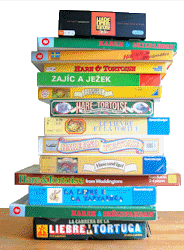
A pile of boxes
What's it all about?

Current UK edition (Gibsons)
- If you play hare-wise, taking great leaps forward at each move, you risk running out of carrots so fast as to lose valuable time trying to get them back. But:
- If you play like tortoise-wise, plodding along as cheaply as possible, you risk lagging so far behind as to never have time to catch up with the hares.
It's the thought that counts
The actual cost of moving is: 1 for the first square, plus 2 for the second, plus 3 for the third... and so on. It therefore costs 1 carrot to move 1 square, 3 to move 2, 6 to move 3, 10 to move 4, etc. To generalise, moving forwards n squares in one turn costs n(n+1)/2 carrots. So, given 65 carrots to start with, you might play tortoise-wise and get home in 65 moves at 1 carrot each and still have 1 carrot left over. Playing hare-wise, you could get home in just one move, but only if you could afford the 2080 carrots such a leap would cost. To add to your problems, the further ahead you are, the fewer the carrots you earn when you land on a pay-out square. In Hare & Tortoise, unlike certain other games, you don't collect 200 carrots every time you pass Go.Fabulous background
In Aesop's classic fable
Specious species
I used to wonder why some commentators switch indiscriminately between tortoise and turtle, and between hare and rabbit, given that tortoises are essentially terrestrial and turtles aquatic. (Tortoises have legs and walk; turtles have flippers and swim). Hares and rabbits are not only different species but different genera to boot. (And hares don't burrow.) All was revealed when I read the following: "British English distinguishes tortoises, which live all their lives on land and have flat feet; terrapins, which live in fresh water and have fins; and turtles, which have fins and live in the sea. In American English they're all turtles." (From a sidenote on page 187 of Caspar Henderson's wonderful Book of Barely Imagined Beings (London 2012).Copyright
